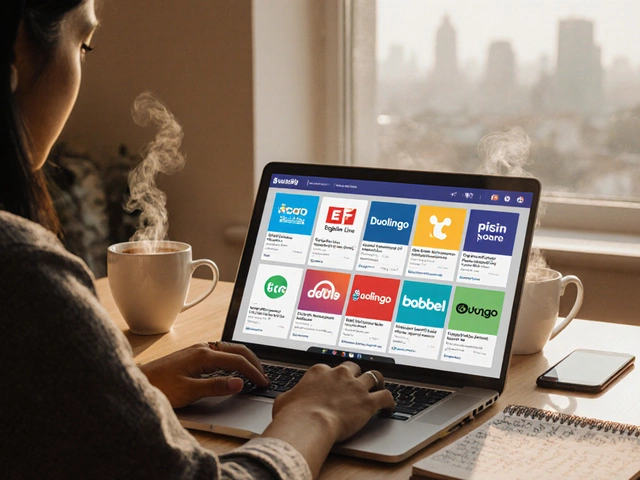
If you think learning to speak English is easy, you probably haven’t tried pushing past that awkward feeling of getting stuck mid-sentence when talking to a stranger. English breaks its own rules, every country has its own slang, and unless you practice with real people, fluency can feel totally out of reach. It’s not just about grammar or vocabulary. It’s about turning your thoughts straight into words—on the spot—without freezing or translating in your head every few seconds. That’s what most “self-study” platforms skip. But in 2025, you’re not stuck with boring textbooks or dusty classroom lectures. Nothing’s holding you back from finding the perfect tool to build real, everyday speaking confidence. But which one actually works?
How Different English Speaking Platforms Work
Online platforms for speaking English aren’t all designed the same way. Some focus on one-on-one video chats with tutors, where you pay per session. Others use group classes, conversation circles, language exchanges, or even AI conversation bots. The big question is: Which setup actually helps you become fluent? Let’s break down the main types of platforms you’ll find when searching for the best English speaking experience.
First, let’s talk about tutor-based platforms. Services like italki, Preply, and Cambly give you direct access to real human tutors, usually native English speakers or certified teachers from around the world. You pick someone with an accent you like—think American, British, or even South African if you want—and schedule sessions whenever it fits your life. These one-on-one lessons put you in the hot seat. Unlike group classes, you get all the attention. Tutors can adjust topics based on your interests, pinpoint weird grammar mistakes, and even catch your nervous habits that block smooth sentences. Cambly, for instance, saw over 2 million users book lessons in 2024 alone, with learners logging in from 190 countries. That speaks volumes about the demand for live, flexible practice.
On the other hand, group classes on platforms like Open English, EF English Live, or even Duolingo MAX offer a classroom vibe—with up to 25 students at a time plus a teacher guiding the session. This mirrors real-world conversations—sometimes you need to speak up, sometimes just listen. For shy folks or those who get stage fright, this can be a little overwhelming at first but is great for developing quick responses and learning how to jump into group chats in English. According to a 2023 Pearson report, 60% of adult English learners in Latin America preferred hybrid group classes to solo study, mainly for this reason: more speakers mean more unpredictable conversations, which means real-life practice.
Some platforms ditch the teacher altogether and go for a peer-to-peer approach. Tandem and Speaky, for example, pair you up with learners who want to practice your language, while you help them with theirs. If your first language is French or Hindi, you might trade half an hour of English speaking with someone who wants to learn your mother tongue. These exchanges are usually free and quirky, but there’s no guarantee the person on the other end is as serious as you are.
Then there are AI chatbots, like Elsa Speak and Speakify, built to give you a “safe zone” for speaking English without embarrassment. These bots listen as you talk, give instant feedback on your pronunciation, and even offer personalized drills. While no robot matches the unpredictability of a real person, these platforms offer an affordable, anytime way to squeeze in practice if you’re pressed for time or want to avoid judgment.
Platforms like Busuu and Babbel now mix video content, AI chat, peer chat, and optional tutors for “all in one” solutions. You start with recorded dialogues, practice with a bot, then jump into live classes or speak with real people as you get braver. According to a Statista survey in early 2025, 54% of language app users said they prefer platforms that offer both live speaking and self-paced drills, proving people want both practice and flexibility.
Not every approach fits every learner. If you want intense, fast improvement and direct correction, tutor-based or group platforms are usually best. If your goal is casual conversation or building confidence without breaking the bank, peer-to-peer and AI tools are great. If you’re an introvert, try an AI speaking app first—once you feel less self-conscious, move on to group video calls or one-on-ones. Mix and match, depending on your goals and daily routine.

The Pros and Cons of Popular English Speaking Platforms
It’s tempting to choose the first slick-looking app or website that promises fluency in six months. But flashy ads rarely match reality. Some platforms shine for casual practice, others help you prep for real-world jobs, exams, or travel. Here’s a head-to-head look at how the biggest names perform for real English speaking improvement—warts and all.
Cambly and Preply top the charts when it comes to one-on-one spoken English practice. Preply, for example, boasts more than 32,000 English tutors from all over the world as of July 2025. The sheer variety means you can pick someone who matches your learning style, accent goals, or even sense of humor. One-on-one lessons remove distractions, so you get instant feedback on your speech, pronunciation, and unusual vocabulary. The downside? It can get expensive—hourly rates range from $5 up to $50 for private tutors, depending on their credentials and country of residence. If you’re not consistent, your skills won’t progress either. Some tutors are fantastic, but others may not fit your personality or teaching needs, so it’s smart to test a few first.
In contrast, group class platforms like Open English (especially popular in Latin America) or EF English Live are subscription-based, which is easier on your wallet if you want unlimited live classes. Some classes focus on pronunciation, others on business English, and many center on conversation topics ranging from world news to travel. A 2024 internal Open English report showed that learners who joined at least three classes per week improved their speaking confidence almost 50% faster than those taking just one. But, there’s a catch—group settings can mean less talk time for you, since the teacher has to split attention among many students. Fast speakers sometimes dominate the conversation, leaving you trailing behind. Still, if you love variety and meeting people from different cultures, this is a huge bonus.
Tandem, HelloTalk, and Speaky push the “language buddy” experience. They’re free, easy to use, and offer connections worldwide, including rare accents (ever chatted with someone from New Zealand or Ghana?). You get cultural nuggets, real slang, and honest feedback from fellow learners or native speakers. But since most chats happen with text at first, you might not get as much actual speaking as you’d hope—unless you push the conversation to calls. There’s also the risk of random drop-offs: people can lose interest or ghost you, especially if you don’t click right away. If you’re persistent and open, though, you may find a real friend or two—and rack up hours of casual conversation.
Now let’s talk about AI-powered English speaking apps. Elsa Speak is something I constantly recommend to friends in Cape Town trying to nail a neutral pronunciation for job interviews abroad. The app listens, analyzes every sound, and gives instant, pinpointed feedback on problem areas—whether it’s that tricky R sound or full sentences. According to Elsa Corp., by January 2025, users practicing for 10 minutes per day improved their pronunciation accuracy by an average of 26% in just four weeks. That’s backed by actual speech science! But you’re still practicing with a bot. It won’t pick up on awkward phrasing, real-world slang, or subtle mistakes like a person would. Still, nothing beats it for drilling sounds, building up speed, and practicing under zero pressure. Combine it with real-life chats and you’ve got a killer setup.
Bigger apps like Duolingo now offer advanced speaking challenges, but they’re often short—great for vocabulary and basic dialog, but you won’t get proper corrections on complex sentences. The “MAX” edition does include video speaking and story-based chat, but it’s best as a stepping stone before facing real people. On the other hand, Busuu’s community feedback lets native speakers rate your audio answers and offer comments, a mix of social media and language learning in one.
Some learners need structured feedback for exams or business presentations—think IELTS, TOEFL, or corporate meetings. Special test-prep platforms like IELTS Liz, IELTS Speaking, and Magoosh specifically coach you for the kind of fluency these tests demand. They offer simulation interviews, timed practice, and real test-style questions. In a 2024 study by British Council South Africa, students boosting their practice with at least two weekly live sessions scored up to 10% higher in the speaking section versus those relying on solo study alone. When stakes are high, live human guidance is hard to beat.
To help compare these options, I put together a quick table with data as of mid-2025. It sums up the biggest platforms, their focus, and what type of learner each one fits best.
| Platform | Format | Main Strength | Best For |
|---|---|---|---|
| Cambly | One-on-one video | Live native tutors, flexible | Serious fluency, business |
| Preply | One-on-one video | Huge tutor choice | Custom lessons, accents |
| Open English | Group classes | Unlimited live classes | Frequent practice, social |
| EF English Live | Group/tutor mix | Business focus, global | Work English, fast-track |
| Tandem | Peer chat/video | Free, real-life slang | Travelers, cultural fans |
| Elsa Speak | AI speech app | Pronunciation feedback | Accent improvement |
| Busuu | Mixed: AI, peer, tutor | Flexible, corrections | Casual/self-paced |
Which to pick? If you’re aiming for job interviews or have a tight timeline, invest in live tutors or business-specific group classes. For building long-term confidence and vocabulary, pair a free peer chat platform with speech-focused apps like Elsa or Busuu. And if you just want to brush up for travel, peer exchanges or Duolingo’s interactive lessons are a fun, low-pressure entry point. The wisest learners usually combine two or more for best results.

Practical Tips and Smart Habits for Speaking English Fluently
Let’s get honest—no matter what app or platform you use, fluency in English doesn’t come without regular, deliberate practice. I remember Gemma and I doing mock interviews over coffee, just to break the ice before speaking to real clients abroad. It’s not about being perfect. It’s about getting words out of your head, past your nerves, and into real sentences—again and again—until it feels as natural as scrolling your phone.
If you want to sound genuinely fluent, don’t fall into the trap of only practicing with bots or scripted dialogues. Real people don’t talk like apps. They use filler words, interrupt each other, get emotional, and even break grammar rules. The best habit is to mix structured lesson time—like booking 30-minute teacher calls twice a week—with casual, spontaneous chats (try inviting a language buddy for five minutes a day just to talk about random stuff). You’ll realize how fast you start responding without translating in your head.
Record your own voice. This is awkward at first but eye-opening. Listen to your pacing, the way you connect words, and your tone. Most platforms let you review your audio, but even the basic voice recorder on your phone works. Compare yourself to native speakers: watch TED talks, YouTube interviews, or podcasts in English, pause, and try repeating not only what they say but also how they say it. Mimic their pauses and intonation. You’ll pick up natural rhythm and expressions, which textbooks don’t teach.
Don’t focus only on “correct” English. Instead, prioritize being understood. Many of my friends in Cape Town who work in tourism got hired even with thick accents, just by becoming clear, confident, and quick to explain themselves. Work on chunking words together (“gonna,” “want to,” “out of” become “gonna,” “wanna,” “outta”), using simple connectors (“so,” “anyway,” “like”), and clearly expressing what you mean—even if it’s not word-perfect every time.
Try this: set a challenge to start a new conversation in English with someone new every day for 30 days. It could be a tutor, a new partner on Tandem, or even a voice note to a friend abroad. Track your streak and reward yourself for sticking with it. Research from Duolingo in January 2025 shows users who practiced speaking at least 10 times per week progressed at double the rate of those who did three or fewer. Consistency always beats cramming.
Use technology to your advantage: let apps analyze your pronunciation, but ask human partners to correct your grammar and suggest better wording. Combine the robot’s patience with the unpredictability and humor of real people. And when life gets busy (because life in Cape Town is anything but predictable), sneak in five-minute drills during your commute or lunch break. Fluency grows quietly, every day you show up.
Set specific, small goals—like being able to introduce yourself, describe your last weekend, or argue about your favorite sport in English. Check off each skill as you nail it. These little wins keep motivation up. Every story you share, every mistake you laugh about, is one step closer to sounding smooth, natural, and—finally—fluent.
Don’t forget: there’s no shame in using subtitles, asking someone to repeat, or pausing to search for a phrase. The world speaks with an accent. Embrace yours but use the tools that nudge you forward, whether that’s a cheerful tutor from Brazil on Preply, a relentless pronunciation AI bot, or a language partner from Nairobi you meet on Tandem. The secret isn’t the app—it’s how you use it, the habits you build, and how bravely you show up, even when you feel silly.





